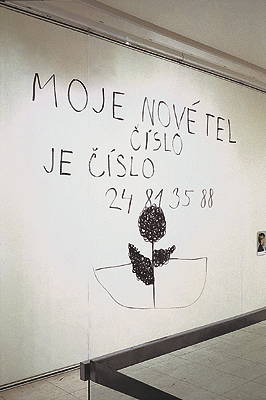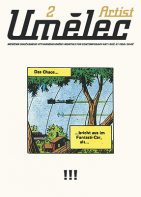| Umělec 1998/2 >> Delayed Polemics Or Reflection of the Budget Cut | Просмотр всех номеров | ||||||||||||
|
|||||||||||||
Delayed Polemics Or Reflection of the Budget CutUmělec 1998/201.02.1998 Vít Havránek a Michal Koleček | reviews | en cs |
|||||||||||||
|
"Trying to collect my notes on the Budget Cut exhibition, I keep on going six months back to reactions of the Czech art scene to megashows of the previous season. Documenta in Kassel and the Venice Biennial were the most watched and visited events among the Czech audience and they instigated various evaluations and complaints of the dismal state of visual art. The exhibitions showed a dominant tendency towards social and political cross-overs in art production (Documenta X was even based on this principle) which caused a shock among many art critics here. Mainly The Atelier magazine (which devoted to the two shows special issues) published several sharp opinions. Having gone through them, a reader has no other choice but to take contemporary art for a loss, or even better to take the writers for a loss.
What should one think for example of the piece in which Josef Vojvodík seriously compares contemporary art’s response to concrete movement in society to products of real-socialism cultural policy and Documenta to a biennial in real-socialist Havana? (The Atelier, 22/97) How should one read the elegy-like text by Jiří Machalický, full of sadness over his own helplessness, or the ironic article by Ludmila Vachtová in which haughty scepticism over the state of the “artworld“ mixes with unconspicuous self-presentation of the author as its integral part? (The Atelier, 20/97) And what should one do with a babble by Izabella Chwastowicz (“Talent and skill are no longer needed, it is enough to have cheeks and political and social feeling. Collection of Contemporary Art is not a place to please the eye and soul but a place of a dramatic story interweaving our problems with failures of human disappointment.“) which would not be even worth noting if not published in the most spread art periodical? (The Atelier, 22/97) I mentioned back to these reviews as they are symptomatic in their reflection of the situation in the Czech art community. It is typical for bashfulness about clearly articulated social issues which is perhaps a result of a totalitarian regime and fear from so-called ideologizing of art production and still underdeveloped awareness of the form of civic society. The relationship of artists and theoreticians to exhibition-goers is also of interest. While the ones who go to exhibitions are marked with disrespect as snobs and insiders, the ones who don’t go are usually considered uneducated, a result of the decay of contemporary world. It is useless to get close to the latter case (for example in the form of long-term educational projects in museums and galleries). It is in this environment that Jana and Jiří Ševčíks tried to present the Budget Cut exhibition and introduce works which would “address broader audience, would work in social space and introduce contemporary reality into art“. (The exhibition’s Infolist) The reason why they made this brave and praiseworthy step may be found in the increasing need to name activities flourishing on the outskirts of Czech art scene and in the two curators’ effort to (formally and thematically) bring near what is happening in the world. The Ševčíks apparently started working on the concept of the exhibition with a clear idea which was influenced by the above-mentioned shows and last year’s Whitney Biennial. Soon it was obvious, however, that the situation in this country is a bit different. The curators invited representatives of new and overall very interesting art communities in regions of the Czech Republic (Brno, Ostrava, Ústí na Labem), foreigners working in Czech Republic, students from Prague art colleges and “tested“ personalities with whom they had worked on their previous projects (That What Is Left, 1993; A Test Run, 1995). It was this inclusion of older and crystallized artists that later proved problematic and I can’t help feeling that it was because of their affiliation with a certain stable rather than their affinity to the topic. (For example Jan Merta, Jiří Kovanda, Vladimír Skrepl, Petr Nikl who tried to violently update his piece, Daniel Balabán, Radek Váňa and a few others.) Though they are very good artists, connecting their work influenced by an emphasis on introspection, poetry of images or antiaesthetics with social-political tendencies is misleading and hurts the event itself. Another problem of the exhibition lies in the certain disguise and unconcrete character of most of the projects presented at the Mánes Gallery. In this case, however, it is not the fault of Jana and Jiří Ševčíks. Quite contrary to this, we may say that this fact is one of the most positive outcomes of the entire project as this is a result of their careful research. If one ought to search for echos of global context in the Czech art scene, it is mostly on a general level. The local scene also reflects themes of violence, sexual orientation, political elites, the environment, racial discrimination, a microworld of specific (often marginal) communities, drug addiction, power of media, etc. Careful observation of the exhibition, however, reveals that their articulation is often significantly impersonal. It is as if most of the artists were not responding to a concrete event, the reality they live in daily, but rather its reflection in the non-world of news reports. There is a direct connection with the state of our “unstable and not yet defined new social and political situation“. (From the Infolist of the exhibition) Just like a major part of the society, artists, too, keep on beating around the bush and try to perfect their schemes of national identity without touching its neuralogic points. Yet we all know about these painful themes. We know about the Romany issue, the ecological catastrophy in North Bohemia and the Ostrava region, the unsettled bills with the totalitarian regime, expulsion of Germans, child abuse and other concrete problems. Some of the works presented at the Budget Cut deal with such issues and it appears that artists from regions are more sensitive to them - and foreigners (part of it may be their experience of otherness and loneliness). Some of the most powerful works are paintings by Jiří Surůvka, the embroided hankies by Beth Zonderman, a monitor by Petr Pastrňák, baked canvases by Jitka Géringová, internet charts by Filip Turek and the Silver group, Czech Benetton by Marek Pražák, the impersonal family album by René Rohan, Romany jokes by Tomáš Polcar, the Semtex pig by Jiří Černický, portraits by Pierre Daguin, etc. The Budget Cut gives the impression that it didn’t meet the curators’ expectations. It is ambigous, sometimes disturbing and rich, at other times boring. We may not like it but the project quite precisely reflects the contemporary atmosphere in Czech society and the art community, including certain disillusionment and sober, growing hope. "
01.02.1998
Рекомендуемые статьи
|
|||||||||||||









Комментарии
Статья не была прокомментированаДобавить новый комментарий